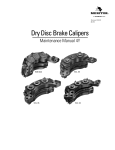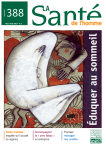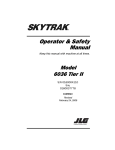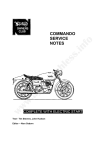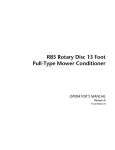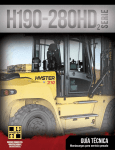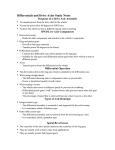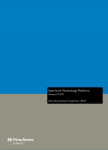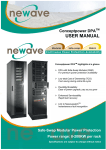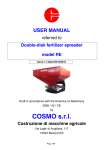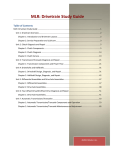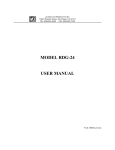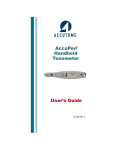Download Section 3 Prepare Parts for Assembly
Transcript
Carrier Box Assembly Ensemble de carter de nej-de-pont Maintenance Manual MM5.3 Manuel de maintenance MM5.3 Models / Mòdeles A4 3200E 2033 293 A4 3200E 2033 292 Issued 6-04 Edité Mai 04 Service Notes Before You Begin This manual provides instructions for AxleTech International’s Carrier Box Assembly. Before you begin procedures: 1. Read and understand all instructions and procedures before you begin to service components. 2. Read and observe all Caution and Warning safety alerts that precede instructions or procedures you will perform. These alerts help to avoid damage to components, serious personal injury, or both. 3. Follow your company’s maintenance and service, installation, and diagnostics guidelines. 4. Use special tools when required to help avoid serious personal injury and damage to components. Safety Alerts, Torque Symbol and Notes ! ! WARNING CAUTION A Warning alerts you to an instruction or procedure that you must follow exactly to avoid serious personal injury. A Caution alerts you to an instruction or procedure that you must follow exactly to avoid damage to components. The torque symbol alerts you to tighten fasteners to a specified torque value. NOTE: A Note provides information or suggestions that help you correctly service a component. The instructions contained in this Field Maintenance Manual are intended for use by skilled and experienced mechanics knowledgeable in the installation, repair and replacement of AxleTech Carrier Box Assembly. Installation, maintenance and replacement of AxleTech Carrier Box Assembly require a high degree of skill and experience. The consequences of improper installation, maintenance or replacement are grave and can result in vehicle drive failure and possible injury to or death of persons. AxleTech does not authorize anyone other than highly skilled and experienced individuals to attempt to utilize the instructions contained in this Manual for the installation, maintenance or replacement of AxleTech Carrier Box Assembly and AxleTech shall have no liability of any kind for damages arising out of (or in connection with) any other use of the information contained in this Manual. Additional Publications For AxleTech service manuals, please contact: 1-877-877-9717 or visit our website at www.axletech.com. How To Order Order items from AxleTech International. Phone orders are also accepted by calling AxleTech International’s Customer Service Center at 877-547-3907 or send a fax to 866-547-3987. For ArvinMeritor brake manuals, please contact their Customer Service Center at 1-800-535-5560 or visit their website at www.arvinmeritor.com. Asbestos and Non-Asbestos Fibers ! ASBESTOS FIBERS WARNING ! NON-ASBESTOS FIBERS WARNING The following procedures for servicing brakes are recommended to reduce exposure to asbestos fiber dust, a cancer and lung disease hazard. Material Safety Data Sheets are available from AxleTech. The following procedures for servicing brakes are recommended to reduce exposure to non-asbestos fiber dust, a potential cancer and lung disease hazard. Material Safety Data Sheets are available from Meritor. Hazard Summary Hazard Summary Because some brake linings contain asbestos, workers who service brakes must understand the potential hazards of asbestos and precautions for reducing risks. Exposure to airborne asbestos dust can cause serious and possibly fatal diseases, including asbestosis (a chronic lung disease) and cancer, principally lung cancer and mesothelioma (a cancer of the lining of the chest or abdominal cavities). Some studies show that the risk of lung cancer among persons who smoke and who are exposed to asbestos is much greater than the risk for non-smokers. Symptoms of these diseases may not become apparent for 15, 20 or more years after the first exposure to asbestos. Accordingly, workers must use caution to avoid creating and breathing dust when servicing brakes. Specific recommended work practices for reducing exposure to asbestos dust follow. Consult your employer for more details. Most recently manufactured brake linings do not contain asbestos fibers. These brake linings may contain one or more of a variety of ingredients, including glass fibers, mineral wool, aramid fibers, ceramic fibers and silica that can present health risks if inhaled. Scientists disagree on the extent of the risks from exposure to these substances. Nonetheless, exposure to silica dust can cause silicosis, a non-cancerous lung disease. Silicosis gradually reduces lung capacity and efficiency and can result in serious breathing difficulty. Some scientists believe other types of non-asbestos fibers, when inhaled, can cause similar diseases of the lung. In addition, silica dust and ceramic fiber dust are known to the State of California to cause lung cancer. U.S. and international agencies have also determined that dust from mineral wool, ceramic fibers and silica are potential causes of cancer. Accordingly, workers must use caution to avoid creating and breathing dust when servicing brakes. Specific recommended work practices for reducing exposure to non-asbestos dust follow. Consult your employer for more details. Recommended Work Practices 1. Separate Work Areas. Whenever feasible, service brakes in a separate area away from other operations to reduce risks to unprotected persons. OSHA has set a maximum allowable level of exposure for asbestos of 0.1 f/cc as an 8-hour timeweighted average and 1.0 f/cc averaged over a 30-minute period. Scientists disagree, however, to what extent adherence to the maximum allowable exposure levels will eliminate the risk of disease that can result from inhaling asbestos dust. OSHA requires that the following sign be posted at the entrance to areas where exposures exceed either of the maximum allowable levels: DANGER: ASBESTOS CANCER AND LUNG DISEASE HAZARD AUTHORIZED PERSONNEL ONLY RESPIRATORS AND PROTECTIVE CLOTHING ARE REQUIRED IN THIS AREA 2. Respiratory Protection. Wear a respirator equipped with a high-efficiency (HEPA) filter approved by NIOSH or MSHA for use with asbestos at all times when servicing brakes, beginning with the removal of the wheels. 3. Procedures for Servicing Brakes. a. Enclose the brake assembly within a negative pressure enclosure. The enclosure should be equipped with a HEPA vacuum and worker arm sleeves. With the enclosure in place, use the HEPA vacuum to loosen and vacuum residue from the brake parts. b. As an alternative procedure, use a catch basin with water and a biodegradable, non-phosphate, water-based detergent to wash the brake drum or rotor and other brake parts. The solution should be applied with low pressure to prevent dust from becoming airborne. Allow the solution to flow between the brake drum and the brake support or the brake rotor and caliper. The wheel hub and brake assembly components should be thoroughly wetted to suppress dust before the brake shoes or brake pads are removed. Wipe the brake parts clean with a cloth. c. If an enclosed vacuum system or brake washing equipment is not available, employers may adopt their own written procedures for servicing brakes, provided that the exposure levels associated with the employer’s procedures do not exceed the levels associated with the enclosed vacuum system or brake washing equipment. Consult OSHA regulations for more details. d. Wear a respirator equipped with a HEPA filter approved by NIOSH or MSHA for use with asbestos when grinding or machining brake linings. In addition, do such work in an area with a local exhaust ventilation system equipped with a HEPA filter. e. NEVER use compressed air by itself, dry brushing, or a vacuum not equipped with a HEPA filter when cleaning brake parts or assemblies. NEVER use carcinogenic solvents, flammable solvents, or solvents that can damage brake components as wetting agents. 4. Cleaning Work Areas. Clean work areas with a vacuum equipped with a HEPA filter or by wet wiping. NEVER use compressed air or dry sweeping to clean work areas. When you empty vacuum cleaners and handle used rags, wear a respirator equipped with a HEPA filter approved by NIOSH or MSHA for use with asbestos. When you replace a HEPA filter, wet the filter with a fine mist of water and dispose of the used filter with care. 5. Worker Clean-Up. After servicing brakes, wash your hands before you eat, drink or smoke. Shower after work. Do not wear work clothes home. Use a vacuum equipped with a HEPA filter to vacuum work clothes after they are worn. Launder them separately. Do not shake or use compressed air to remove dust from work clothes. 6. Waste Disposal. Dispose of discarded linings, used rags, cloths and HEPA filters with care, such as in sealed plastic bags. Consult applicable EPA, state and local regulations on waste disposal. Regulatory Guidance References to OSHA, NIOSH, MSHA, and EPA, which are regulatory agencies in the United States, are made to provide further guidance to employers and workers employed within the United States. Employers and workers employed outside of the United States should consult the regulations that apply to them for further guidance. Recommended Work Practices 1. Separate Work Areas. Whenever feasible, service brakes in a separate area away from other operations to reduce risks to unprotected persons. 2. Respiratory Protection. OSHA has set a maximum allowable level of exposure for silica of 0.1 mg/m3 as an 8-hour time-weighted average. Some manufacturers of non-asbestos brake linings recommend that exposures to other ingredients found in non-asbestos brake linings be kept below 1.0 f/cc as an 8-hour time-weighted average. Scientists disagree, however, to what extent adherence to these maximum allowable exposure levels will eliminate the risk of disease that can result from inhaling non-asbestos dust. Therefore, wear respiratory protection at all times during brake servicing, beginning with the removal of the wheels. Wear a respirator equipped with a high-efficiency (HEPA) filter approved by NIOSH or MSHA, if the exposures levels may exceed OSHA or manufacturer’s recommended maximum levels. Even when exposures are expected to be within the maximum allowable levels, wearing such a respirator at all times during brake servicing will help minimize exposure. 3. Procedures for Servicing Brakes. a. Enclose the brake assembly within a negative pressure enclosure. The enclosure should be equipped with a HEPA vacuum and worker arm sleeves. With the enclosure in place, use the HEPA vacuum to loosen and vacuum residue from the brake parts. b. As an alternative procedure, use a catch basin with water and a biodegradable, non-phosphate, water-based detergent to wash the brake drum or rotor and other brake parts. The solution should be applied with low pressure to prevent dust from becoming airborne. Allow the solution to flow between the brake drum and the brake support or the brake rotor and caliper. The wheel hub and brake assembly components should be thoroughly wetted to suppress dust before the brake shoes or brake pads are removed. Wipe the brake parts clean with a cloth. c. If an enclosed vacuum system or brake washing equipment is not available, carefully clean the brake parts in the open air. Wet the parts with a solution applied with a pump-spray bottle that creates a fine mist. Use a solution containing water, and, if available, a biodegradable, non-phosphate, waterbased detergent. The wheel hub and brake assembly components should be thoroughly wetted to suppress dust before the brake shoes or brake pads are removed. Wipe the brake parts clean with a cloth. d. Wear a respirator equipped with a HEPA filter approved by NIOSH or MSHA when grinding or machining brake linings. In addition, do such work in an area with a local exhaust ventilation system equipped with a HEPA filter. e. NEVER use compressed air by itself, dry brushing, or a vacuum not equipped with a HEPA filter when cleaning brake parts or assemblies. NEVER use carcinogenic solvents, flammable solvents, or solvents that can damage brake components as wetting agents. 4. Cleaning Work Areas. Clean work areas with a vacuum equipped with a HEPA filter or by wet wiping. NEVER use compressed air or dry sweeping to clean work areas. When you empty vacuum cleaners and handle used rags, wear a respirator equipped with a HEPA filter approved by NIOSH or MSHA, to minimize exposure. When you replace a HEPA filter, wet the filter with a fine mist of water and dispose of the used filter with care. 5. Worker Clean-Up. After servicing brakes, wash your hands before you eat, drink or smoke. Shower after work. Do not wear work clothes home. Use a vacuum equipped with a HEPA filter to vacuum work clothes after they are worn. Launder them separately. Do not shake or use compressed air to remove dust from work clothes. 6. Waste Disposal. Dispose of discarded linings, used rags, cloths and HEPA filters with care, such as in sealed plastic bags. Consult applicable EPA, state and local regulations on waste disposal. Regulatory Guidance References to OSHA, NIOSH, MSHA, and EPA, which are regulatory agencies in the United States, are made to provide further guidance to employers and workers employed within the United States. Employers and workers employed outside of the United States should consult the regulations that apply to them for further guidance. Table of Contents Exploded Views Center Assembly-Carrier Box..........................................................................................................................2 Carrier Assembly.............................................................................................................................................3 Section 1: Introduction Identification ....................................................................................................................................................4 Descriptions.....................................................................................................................................................4 Section 2: Disassembly Carrier Assembly Box......................................................................................................................................4 Disassembly From Vehicle..............................................................................................................................5 Carrier Box Assembly Disassembly ................................................................................................................5 Removal of The Carrier Assembly From The Carrier Box Assembly..............................................................5 Carrier Disassembly Procedures ....................................................................................................................6 Disassembly of the Differential Cases ............................................................................................................8 Carrier Box Final Disassembly........................................................................................................................8 Section 3: Prepare Parts for Assembly Clean Ground or Polished Parts .....................................................................................................................9 Clean Parts With A Rough Finish....................................................................................................................9 Clean The Carrier Box Housing ......................................................................................................................9 Drying Cleaned Parts ......................................................................................................................................9 Preventing Corrosion ......................................................................................................................................9 Inspecting Parts ..............................................................................................................................................9 Cleaning The Breather ....................................................................................................................................9 Tapered Roller Bearings................................................................................................................................10 Pinions And Gears.........................................................................................................................................11 Main Differential Assembly ............................................................................................................................11 Output Shafts.................................................................................................................................................11 Repair Or Replace Parts ...............................................................................................................................11 Welding Repair ..............................................................................................................................................11 Removing Dri-Loc Fasteners.........................................................................................................................11 Installing Fasteners With Pre-Applied Adhesive ...........................................................................................12 Installing Original Or Used Fasteners ...........................................................................................................12 Apply Liquid Gasket Material ........................................................................................................................12 Flush Lube From The Carrier Box ................................................................................................................13 Gearset Information (Drive Pinion And Ring Gear Marks)............................................................................13 Section 4: Assembly Assembling the Pinion Bearing Cage ...........................................................................................................14 Assembling the Differential Case ..................................................................................................................14 Installing the Drive Pinion .............................................................................................................................15 Installing the Differential Case Assembly......................................................................................................15 Carrier Bearing Preloads...............................................................................................................................16 Installing Carrier Assembly Into Carrier Box .................................................................................................17 Torque Table..................................................................................................................................................18 Section 5: Adjustments Checking the Ring Gear Backface Runout ...................................................................................................19 Adjusting the Gearset Backlash....................................................................................................................19 Adjusting Tooth Contact Pattern of the Gearset ...........................................................................................20 Section 6: Lubrication Magnet Drain Plug ........................................................................................................................................23 Breather.........................................................................................................................................................23 Seals .............................................................................................................................................................23 Oil Level ........................................................................................................................................................23 Carrier Oil Box Recommendations ...............................................................................................................23 Approved Oil Listings ....................................................................................................................................23 Approved Grease Recommendations for Carrier Box Assembly..................................................................23 Section 7: Tool Section How to Make a Yoke Bar ..............................................................................................................................24 Exploded View Center Assembly-Carrier Box 11 10 9 8 1 7 16 6 12 13 14 5 4 2 3 15 Item Description 1 HSG Assy-Carrier Box 2 3 4 5 Quantity Item Description 9 Washer-Flat 12 10 Yoke-Output 2 Capscrew 12 11 Locknut 2 Shaft-Output L.H. 1 12 Lock 2 Shaft-Output R.H. 1 13 Capscrew 4 6 Bearing-Ball 2 14 Plug-Fill Level 1 7 O-Ring 2 15 Plug/Drain Magnetic 1 8 Cage-Output 2 16 Breather Assy 1 Page 2 Seal Quantity 1 2 Exploded View Carrier Assembly 27 24 25 26 22 21 23 1 19 2 18 3 17 4 20 5 16 6 7 8 9 10 15 11 14 12 13 Item Description 1 Diff.-Carr & Cap Assy 2 3 Quantity Item Description Quantity 1 15 Lock 1 Cup-Bearing 1 16 Cotter 2 Bearing Cone 1 17 Ring-Brg Adj, Fin 2 4 Shim .012 inch As Required 18 Cup-Bearing 2 5 Shim .008 inch As Required 19 Cone-Bearing Assy 2 6 Pinion-Spiral Bevel 1 20 Capscrew 16 7 Bearing Cone-Outer 1 21 Case Assy Diff 1 8 Cup-Bearing 1 22 Washer-Side Gear Thrust 2 9 O-Ring 1 23 Side Gear-Diff 2 10 Cage Assy-Input 1 24 Washer-Pinion Thrust 4 11 Seal Assy 1 25 Pinion-Diff 4 12 Yoke Input 1 26 Spider-Diff 1 13 Locknut 1 27 Gear Assy-Spiral Bevel 1 14 Capscrew 2 Page 3 Section 1 Description Carrier Box Service Manual Figure 1.1 Identification: CARRIER BOX ASSEMBLY IDENTIFICATION TAG LOCATION To determine the exact axle model and specification, refer to the identification tag located on the carrier box assembly as shown in Figure 1.1. Description: AxleTech International carrier box assembly incorporates a single reduction spiral bevel gearing carrier assembly mounted in a carrier box housing for remote drive axle assembly. Figure 1.2. AxleTech The AxleTech carrier box assembly permit the output shafts to carry torsional and axial loads. MODEL A43200E2033292 CUST No. • Power is transmitted by the Spiral Bevel gear set in the carrier to the output shafts. SERIAL No. RATIO 2.92:1.0 DATE • The power is then transmitted into associated Chaincases with planetary hub reductions for final vehicle drive. Figure 1.2 CROSS-SECTION OF CARRIER BOX ASSEMBLY Spiral Bevel Gear Carrier Box Ball Bearing Output Seal Output Shaft Output Yoke Lock Nut Output Yoke O-Ring Output Ball Bearing Cage Shims Input Seal Pinion Cage Input Yoke Spiral Bevel Pinion Page 4 Section 2 Disassembly Disassembly From Vehicle: ! WARNING To prevent serious eye injury, always wear safe eye protection when you perform vehicle maintenance or service. Park the vehicle on a level surface. Block the wheels to prevent the vehicle from moving. Support the vehicle with safety stands. Do not work under a vehicle supported only by jacks. Jacks can slip and fall over. Serious personal injury and damage to components can result. OEM service instructions should be followed when servicing these components under the vehicle. NOTE: Any pre-cleaning on vehicle to remove dirt/grease or corrosive material should be per vehicle manufacturer recommendations. Care should be taken to cover the carrier box breather to limit additional contamination during pre-cleaning process. 1. Remove the drain plug (3/4"-14) to drain the lubricant into a suitable container. Note amount of metal on the magnetic drain plug and clean drain plug. 2. Discard the drained lubricant in an environmentally responsible manner, according to state and/or (EPA) recommendations. 3. Disconnect the vehicle propshaft from the carrier box input yoke and both output yoke prop shafts from each chain case assembly input yoke per vehicle manufacturer recommendations. Care should be taken so personal injury does not occur. 4. Support the carrier box assembly for safe removal from the vehicle chassis frame. 5. Remove the carrier box assembly from the vehicle per vehicle manufacturer recommended procedures and place on adequate work bench to prepare for disassembly. Carrier Box Assembly Disassembly: Initial disassembly required for carrier assembly removal for inspection or service requires the removal of the (2) output shafts assemblies. Each output shaft assembly may be removed as a total subassembly. 1. To remove each output shaft assembly, remove the (2) M6x1.0 capscrews and lock tab located above the output yokes on the carrier box assembly. 2. Unscrew counter clockwise the output ball bearing cage that retains the shaft assembly on each assembly. 3. Remove as a sub-assembly the output yoke, yoke lock nut, bearing cage, output shaft, ball bearing, and O-ring and set on the work bench. NOTE: The lock nut was assembled with a thread lock applied to the M24x1.5 nut threads. 4. To remove the yoke lock nut, set the assembly in a vise to restrain the yoke ears. Use wrench to loosen lock nut. An optional method to remove the yoke lock nut is to use a yoke bar. This procedure and yoke bar tool description is shown in the tool section of this manual. 5. Remove the yoke from the shaft assembly. 6. Remove the bearing cage, oil seal, O-ring from the output shaft assembly and set aside for later cleaning, inspection and reassembly. ! WARNING Observe all warnings and cautions provided by the press manufacturer to avoid damage to components and serious personal injury. NOTE: Care should be taken not to press on the ball bearing outer journal as damage to bearing could occur. 7. Remove the ball bearing from the output shaft by placing these components vertically in a hydraulic press and use a suitable tube cylinder of correct diameter to touch the inner bearing race only to allow the bearing to be pressed off the output shaft. Prior to actually pressing the bearing, recommend a suitable container be placed below the area where the output shaft will be pressed out of the ball bearing and the container have some soft impact material so the shaft is not damaged when pressed thru the ball bearing and personal injury does not occur. Place these components on the workbench for later cleaning, inspection, and reassembly. Removal Of The Carrier Assembly From The Carrier Box Assembly: NOTE: These capscrews have thread compound applied to the threads during production assembly. 1. Loosen and remove the (12) M12X1.25 capscrews with washers from the carrier assembly to carrier box mounting pattern. ! WARNING Take care when using lifting devices. When you use a lifting strap, inspect the strap for damage before you use it. Do not use a lifting strap to shock load or drop load a component. Serious personal injury and damage to components can result. Page 5 Section 2 Disassembly 2. Attach the lifting strap and lifting device to the carrier input yoke in a safe method to apply tension to the strap. See Figure 2.1. Figure 2.2 Figure 2.1 Figure 2.3 3. Use (2) M12x1.25 capscrews in the threaded holes at top and bottom or carrier to loosen and separate the carrier assembly from the carrier box. 4. Remove the carrier assembly from the carrier box assembly and place safely and secure in either a carrier stand or on the workbench so the carrier will not fall and cause personal injury or component damage. Carrier Disassembly Procedure: Should the carrier upon inspection require disassembly, please follow the following steps after the carrier is securely retained for safe disassembly so no personal injury can occur. A carrier stand that will permit the carrier assembly is recommended as the carrier assembly must be rotated to teardown and built from both top and bottom access areas of the assembly. ! Figure 2.4 WARNING To prevent serious eye injury, always wear safe eye protection when you perform vehicle maintenance or service. 1. Use a small lb-in torque wrench at input yoke or else attach a spring scale to the yoke and rotate the yoke by pulling on the spring scale. Observe and record the total preload measurement value indicated on the spring scale. Figure 2.2. 2. Measure and record the ring gear backface runout Figure 2.3 and the gearset backlash Figure 2.4 values. 3. Using a snap ring pliers, remove the snap ring from the carrier input yoke (if used). Page 6 NOTE: exploded view shows item #13 as a lock nut which is available on later carrier designs. Early production design uses a snap ring and washer to retain the input pinion yoke. Section 2 Disassembly The input pinion lock nut can be removed using the same (2) options as the output shaft lock nut in item #4 (Page 5) of the carrier box disassembly instructions above. When a lock nut is fitted, thread compound has been used on pinion nut threads during production assembly. 9. Remove the adjusting ring and bearing cup from the bearing cap side. Figure 2.5. Figure 2.5 1. Remove the carrier input yoke. 2. Remove the oil seal from the input cage assembly and discard. 3. Remove the (2) capscrews (M6X1.0) and lock plate from the carrier input bearing cage that retain input bearing cage in carrier assembly. 4. Remove the bearing cage O-ring and taper bearing cup by un-screwing in a counter clockwise direction. 5. Remove the spiral bevel pinion with (2) bearing cones and shims as an assembly. The pinion bearings should be removed by using a hydraulic press with a similar procedure as item #7 (Page 5) in removing the ball bearing from the output shafts above. A suitable bearing puller must also be used behind the cone to remove the bearing cones. The puller must fit correctly under the inner face of the cone to avoid damage to the cone. Measure, record and save for later re-assembly any shims removed from behind inner bearing cone assembly on the spiral bevel pinion. 10. Tilt the differential case and ring gear assembly slightly toward the bearing cage saddle. Carefully remove the differential case and ring gear assembly and set on the work bench. Figure 2.6. Figure 2.6 6. Rotate the carrier assembly over for the ring gear facing upwards. 7. Remove the cotter pin that lock the ring gear bearing adjusting ring and loosen the adjusting rings. 8. Remove the differential bearing cap bolts and cap from the carrier assembly. 11. To remove the inner bearing cup from the carrier housing and the outer bearing cup from the pinion bearing cage. Use a press and sleeve or a small drift and brass hammer to remove the bearing cup. Do not damage the ring journals when you remove the bearing cup. Page 7 Section 2 Disassembly Disassembly of the Differential Cases: Continued disassembly of the differential nest components should that be required is done as follows: 1. Make alignment marks from the ring gear to the case halves. Figure 2.7. Figure 2.7 2. Remove the capscrews that retain the (2) differential case halves and remove the components inside the assembly. These components include the differential spider, (4) planet pinions and washers, (2) side gears and washers. Figure 2.8. Figure 2.8 Page 8 ! WARNING Use a rawhide or brass mallet for assembly and disassembly procedures. Do not hit steel parts with a steel hammer. Pieces of a part can break off and cause serious personal injury. 3. Inspect the spiral bevel ring gear for damage. If removal of the ring gear is required; separate the ring gear from the differential case half with a brass hammer. Section 3 Prepare Parts for Assembly Clean Ground or Polished Parts ! WARNING To prevent serious eye injury, always wear safe eye protection when you perform vehicle maintenance or service. Solvent cleaners can be flammable, poisonous and cause burns. Examples of solvent cleaners are carbon tetrachloride, emulsion-type cleaners and petroleum-based cleaners. To avoid serious personal injury when you use solvent cleaners, you must carefully follow the manufacturer’s product instructions and these procedures: • Wear safe eye protection. • Wear clothing that protects your skin. • Work in a well-ventilated area. • Do not use gasoline or solvents that contain gasoline. Gasoline can explode. • You must use hot solution tanks or alkaline solutions correctly. Follow the manufacturer’s instructions carefully. • Use a cleaning solvent, kerosene or diesel fuel, to clean ground or polished parts or surfaces. NEVER USE GASOLINE. • Remove gasket material from parts. Take care not to damage ground surfaces. • DO NOT clean ground or polished parts in a hot solution tank, water, steam or alkaline solution. Dry Cleaned Parts • Dry the parts immediately after cleaning and washing. • Dry the parts with soft clean paper or rags. ! CAUTION Damage to bearing can be caused if dried by rotating with compressed air. • Except for bearings, parts can be dried with compressed air. Preventing Corrosion • Apply a light lubricant to cleaned and dried parts that are not damaged and are to be assembled. • Apply a special material that prevents corrosion to all surfaces. If parts are to be stored, wrap the parts in special paper that prevents corrosion. Inspecting Parts It is very important to inspect all parts carefully and completely before the carrier and carrier box assembly is assembled. Check all parts for wear and replace damaged parts. Replacement of damaged or worn parts will prevent breakdown of assembly later. Cleaning the Breather 1. Remove the breather from the carrier box assembly. Clean Parts with a Rough Finish 2. Clean the breather. If the breather remains dirty after you clean it, replace the breather. • Parts with a rough finish can be cleaned with cleaning solvent or in a hot solution tank with a weak alkaline solution. 3. Apply compressed air to the breather. If the compressed air does not pass through the breather after cleaning, replace the breather. • Parts must remain in hot solution tanks until completely cleaned and heated. 4. Install the breather in the carrier box housing. • Parts must be washed with water until the alkaline solution is removed. Clean The Carrier Box Housing • The carrier box assembly can be steam cleaned on the outside to remove dirt, grease or external contamination. • Before the carrier box assembly is steam cleaned, close or put a cover over the breather on top of the carrier box assembly NOTE: Do not direct steam cleaning spray directly at the carrier input or output yokes & seal assemblies during the initial cleaning as could attempt to push external dirt into the carrier box assembly components. • Remove all metallic particles from the magnetic drain plug. Page 9 Section 3 Prepare Parts for Assembly Tapered Roller Bearings Inspect the cup, cone, rollers and cage of all tapered roller bearings in the assembly. If any of the following conditions exist, replace the bearing: • The centers of the large diameter end of the rollers are worn level with or below the surface. • The centers of the large diameter end of the rollers are worn to a sharp edge. Figure 3.3. • Damage on rollers and on surfaces of the cup and cone inner race that touch the rollers. Figure 3.4. Figure 3.3 • The centers of the large diameter end of the rollers are worn to a sharp edge. Figure 3.1. Figure 3.1 WORN RADIUS WEAR MARKS WORN SURFACE • A visible roller groove in the cup or cone inner race surfaces. The groove can be seen at the small or large diameter end of both parts. Figure 3.2. Figure 3.2 CRACK WEAR GROOVES • Deep cracks or breaks in the cup, cone inner race or roller surfaces. Page 10 • A visible roller groove is worn in the cup or cone inner race surfaces. You can see the groove at the small or large diameter ends of both parts. Figure 3.4. Figure 3.4 ETCHING AND PITTING Section 3 Prepare Parts for Assembly Pinions and Gears ! CAUTION Spiral bevel pinion and gear are machined in a matched set. When a pinion or ring gear of a set needs to be replaced, both the gear and pinion must be replaced at the same time. 1. Inspect the bevel drive pinions and ring gears for wear and damage. Gears that are worn or damaged must be replaced. 2. Verify the condition of the bearing cone seats and spline on the pinion shaft. Main Differential Assembly ! CAUTION Always replace thrust washers, differential side gears and pinion gears in full matched sets. A higher stress on original parts and early failure of the entire assembly will result if a new part is used in combination with parts that are older or worn. Inspect the main differential assembly. Parts that are damaged must be replaced. Inspect the following parts for wear or stress. Figure 3.5. • Inside surfaces of both case halves. • Both surfaces of all thrust washers. • Trunnion ends of the spider cross or differential pinion shaft. • Teeth, splines and thrust surface of differential Output Shafts Inspect output shafts for wear and cracks on the shaft body or in the splines. Replace output shaft, if required. These shafts may be serviced individually as required. Repair or Replace Parts Replace the worn or damaged parts of an carrier box assembly. The following are some examples to check for repair and possible replacement: • Replace any fastener if corners of the head are worn. • Replace washers if damaged. • Replace oil seals or grease seals at the time of carrier box repair. • Clean parts and apply new liquid gasket material where required when the carrier box is assembled. • Remove nicks, marks and burrs from parts having machined or ground surfaces. Use a fine file, India stone, emery cloth or crocus cloth for this purpose. ! CAUTION Thread must be without damage and clean so that accurate adjustment and correct torque values can be applied to fasteners and parts. • Clean and repair the threads of fasteners and holes. Use a die or tap of the correct size or a fine file for this purpose. • Refer to “Torque Table” in Section 4, when tightening all fasteners. side gears. • Teeth, bore and thrust surface of differential pinions. Figure 3.5 Welding Repair The carrier box assembly housing material is Not suitable for welding repair. Do not attempt to repair weld this carrier box assembly. Removing Dri-Loc Fasteners If it is difficult to remove fasteners from components, the strength of Dri-Loc, adhesive or Loctite 277 can be decreased by heating. Refer to the following procedure. ! CAUTION Do not exceed 177° C (350° F) maximum. Heating must be done slowly to prevent thermal stresses in the other components. 1. Heat the fastener for three to five seconds only. Try to loosen the fastener with a wrench. Do not use an impact wrench to loosen the fastener or hit the fastener with a hammer. 2. Repeat Step 1 until you remove the fastener. Page 11 Section 3 Prepare Parts for Assembly Installing Fasteners With Pre-Applied Adhesive, AxleTech Liquid Adhesive, Loctite Liquid Adhesive or Equivalent Installing New Fasteners With Pre-Applied Adhesive Patches 1. Clean the oil and dirt from threaded holes. Use a wire brush. ! CAUTION Do not apply adhesives or sealant on new fasteners with pre-applied adhesive patches or inside closed threaded holes. If other adhesives or sealants are used, the new adhesive will not function correctly. 2. Assemble the parts using the new pre-applied adhesives fasteners. NOTE: There is no drying time required for fasteners with pre-applied adhesive. 3. Refer to “Torque Table” in Section 4 and tighten the fasteners to the specified torque. Installing Original or Used Fasteners Using Thread Compounds During Assembly: Three Bond 1305 and 1334, Loctite 241, 242, 243, 271 and 273 or Equivalent ! WARNING Take care when you use adhesives, thread locking compounds or any sealants to avoid serious personal injury. Follow the manufacturer’s instructions to prevent irritations to the eyes and skin. 1. Clean the oil and dirt and old adhesive for all threads and threaded holes. Use a wire brush. 2. Refer to “Torque Table” to select correct thread compounds. 3. Apply four or five drops of liquid adhesive inside each threaded hole. ! CAUTION Do not apply adhesive directly to the fastener threads in blind holes. Air pressure will build up and push the adhesive out and away from mating surfaces as the fastener is installed. 4. Refer to “Torque Table” in Section 4 and tighten the fasteners to the specified torque. Page 12 Apply Liquid Gasket Material ! WARNING ! WARNING Take care when you use adhesives, thread locking compounds or any sealants to avoid serious personal injury. Follow the manufacturer’s instructions to prevent irritations to the eyes and skin. Take care when you use silicone gasket materials to avoid serious personal injury. Follow the manufacturer’s instructions to prevent irritation to the eyes and skin. AxleTech recommends the following liquid gasket materials: • Three Bond Liquid Gasket No. TB 1216 (Grey) • Loctite Ultra Grey Adhesive/Sealant #18581 • From AxleTech: Ten-ounce tubes, Part No. 2297-F-7052 1. Remove all the old gasket material from both surfaces. 2. Clean the surfaces where the silicone gasket material will be applied. Remove all the oil, grease, dirt and moisture without damaging the mating surfaces. 3. Dry both surfaces. ! CAUTION The amount of silicone gasket material applied must not exceed 3 mm (0.125-inch) diameter bead. Too much gasket material can block lubrication passages and result in damage to the components. 4. Apply 3 mm (0.125-inch) maximum diameter continuous bead of the silicone material at the carrier pilot diameter. Keep bead far away from bolt holes to prevent sealant from getting in between mating threads during bolt installation. This could significantly reduce the effectiveness of the thread locking compound. Figure 3.6. 5. Assemble the components immediately to permit the silicone gasket material to compress evenly between parts. Tighten the fasteners to the specified torque. Refer to the “Torque Table” in Section 4 of this manual. 6. Wait 20 minutes before filling the assembly with lubricant. Section 3 Prepare Parts for Assembly Figure 3.6 Figure 3.7 Flush Lube From the Carrier Box 2. Tooth Combination Number The carrier box assembly contains its own oil. 1. Remove the magnetic oil drain plug and clean all debris from the magnet before re-assembly in the carrier box housing. 2. The oil fill plug is not magnetic. 3. Flush all lubricant from the entire carrier box housing, before you re-assemble the carrier box assembly. Gearset Information (Drive Pinion and Ring Gear Marks) Read the following before installing a new gearset in the carrier. Always inspect the gearset for correct marks to make sure the gears are a matched set. The locations of the gearset marks are shown in Figure 3.7. 1. Part Number a. Examples of gearset part numbers • Conventional ring gear, 881151002 • Conventional drive pinion, 881101002E b. Location on Drive Pinion: Shaft end. c. Location on Ring Gear: Front face or outer diameter. a. Example of a tooth combination number:12-35 NOTE: An 12-35 gearset has an 12-tooth drive pinion and a 35-tooth ring gear. b. Location on Drive Pinion: Shaft end. c. Location on Ring Gear: Front face or outer diameter. 3. Gearset Match Code AxleTech drive pinions and ring gears are available as matched sets. Both gears of a set have a match code. a. Example of gearset match code: M29. NOTE: A gearset match code has any combination of a number or letter, and number. b. Location on Drive Pinion: End of gear head. c. Location on Ring Gear: Front face or outer diameter. 4. Pinion Cone Variation Number NOTE: The pinion cone variation number is not used when checking for a matched gearset. The number is used when you adjust the depth of the pinion in the carrier. a. Examples - Pinion cone variation numbers: • PC+3 • +2 • +0.01 mm • PC-5 • -1 • -0.02 mm b. Location on Gearset: End of pinion gear head or outer diameter of ring gear. Page 13 Section 4 Assembly Assembling the Pinion Bearing Cage ! 4. Install the following components in the ring gear case half. • Spider (4-pinion differential nests) Figure 4.1. • Differential pinions and washers WARNING To prevent serious eye injury, always wear safe eye protection when you perform vehicle maintenance or service. Figure 4.1 Observe all warnings and cautions provided by the press manufacturer to avoid damage to components and serious personal injury. 1. Place the bearing cage in a press. 2. Support the bearing cage with metal or wood blocks. 3. Press the bearing cup into bore of the carrier housing or bearing cage until the cup is flat against bottom of bore. Use the correct size sleeve to install cup. 4. Press the outer bearing cone onto the shaft of the drive pinion until the cone is flat against the gear head. Use a correct size sleeve against the bearing inner race. 5. Install and center the required selective shim pack on the pinion spigot. 6. Press the inner bearing cone onto the drive pinion until the cone is flat against the gear head. If you install a new bevel gearset: 5. Install the other differential case half on top of the case half you assembled in Step 4, matching spider legs to half-round slots. 6. Install the ring gear on the case half. Align the reference marks made during disassembly. If necessary, heat the ring gear to 140°C (284°F) maximum to aid assembly. Figure 4.2. Figure 4.2 7. Set axial position of drive pinion by installing a selective shim pack between pinion and inner bearing cone. Combine basic shims according to the table below. Shim pack thickness is correct if gearset tooth contact pattern comes out good. Refer to Section 5. Shim Pack Thickness (mm) 0.2 0.3 0.4 0.5 0.6 Number of 0.2-thick 1 - 2 1 - Basic shims 0.3-thick - 1 - 1 2 Assembling the Differential Case 1. Apply the specified lubricant to all parts of differential case assembly before installation. 2. Press the bearing cones on both differential case halves. 3. Install the thrust washer and side gear in each case half. Insert washer tab in one of the lubrication openings of the case. 7. Install the differential case to ring gear capscrews. Apply thread compound and alternately tighten. Refer to the “Torque Table” in Section 4. 8. Use a 0.025 mm (0.001-inch) thick feeler gauge to measure the gear bore to differential case pilot clearance. Feeler should not go in more than three places, and arc length should not exceed 25 mm (1-inch) in each place. 9. Use a feeler gauge to measure the gear backface to differential case flange clearance. The clearance must not exceed 0.08 mm (0.003-inch). Page 14 Section 4 Assembly Installing the Drive Pinion 1. Apply the specified lubricant to the pinion bearings and cups. Refer to Section 5. 2. Insert pinion into carrier housing. 3. Versions with oil seal only: Install pinion oil seal flush with face of pinion cage. 4. Apply lubricant to O.D. of pinion bearing cage, and O-ring if there is one. 5. Set pinion bearing preload by threading cage into carrier housing and verifying that cage lock plate matches one of the four possible positions. 6. Use a small lb-in torque wrench at input yoke or else attach a spring scale to the U-joint yoke or clamping device. Rotate the drive pinion by pulling the spring scale. Observe the scale movement. Figure 4.3. Figure 4.3 12. Slide U-joint yoke onto pinion spline. Install washer and snap ring with the beveled edge facing out. Do not install shims yet. 13. Measure axial endplay of U-joint yoke, which should fall within the 0.05-0.56 mm (0.002-0.022-inch) range. 14. Calculate shim pack thickness by adding 0.15 mm (0.006-inch) to endplay and rounding down to the nearest 0.10 mm (0.004-inch). Combine basic shims. Refer to the table below. Shim Pack Thickness (mm) 0.2 0.3 0.4 0.5 0.6 Number of 0.2-thick 1 - 2 1 - Basic shims 0.3-thick - 1 - 1 2 Example of shim selection: measured axial endplay = 0.42 ideal shim pack thickness = 0.42 + 0.15 = 0.57 rounding down = 0.5 from table =(1 x 0.2-thick shim) + (1 x 0.3-thick shim) 15. Disassemble snap ring and washer. 16. Install shim pack, washer and snap ring with the beveled edge facing out. Washer contacts snap ring, and not U-joint yoke. 17. Lightly tap yoke against carrier housing to help seat the snap ring. Figure 4.4 7. If the preload measurement does not equal 520 lb-in (5.8-23 kgf.cm): Adjust the preload by rotating the drive pinion bearing cage as necessary. 8. Record the pinion bearing preload measurement. Refer to the measurement when you set the differential case bearing preload. 9. Hold the pinion cage lock plate with bolts. Apply thread compound and tighten. Refer to the “Torque Table” in Section 4. 10. Apply RTV sealant inside yoke counterbore at bearing end of yoke spline. Then assemble yoke onto shaft spline and wipe excess RTV off of yoke’s surface where washer and locknut will assemble on threaded shaft. 11. Apply thread compound on flanged locknut threads hold yoke with yoke bar and torque yoke locknut per “Torque Table” in section 4. The remaining steps are for versions with U-joint yoke that uses snap ring, washer and shims. Figure 4.4. Installing the Differential Case Assembly 1. Apply the specified lubricant to the differential case bearings and cups. 2. Install the differential case in the carrier. Figure 4.5. Page 15 Section 4 Assembly 3. Install the bearing cups, adjusting rings, bearing cap, and bearing cap bolts. Apply thread compound and tighten. Refer to the “Torque Table” in Section 4. Figure 4.6. Figure 4.5 8. If the total bearing preload or bevel gearset backlash does not meet specification, rotate the adjusting rings to get the target values. 9. Check ring gear backface runout and gearset tooth contact pattern. Refer to Section 5. 10. Install the cotter pins to lock the adjusting rings. Figure 4.6. Carrier Bearing Preloads [lb-inch] Table A: Carrier Total (Differential Case) Bearing Preload (inch units) Setting the Bearing Preload (As Rolling Torque At Pinion) • Assemble pinion assembly • Measure pinion bearing preload; locate value under “Pinion Bearing.” • Assemble differential case and ring gear assembly. • Measure total bearing preload; it must be within range under “Total Bearing.” Figure 4.6 Specified Rolling Torques [lb-in] Pinion bearing preload: 5.0 Differential bearing preload: 10.0 20 25.0 Note: 1 lb-in = 0.113 N.m = 1.114 kgf.cm Bevel Gearset Ratio: Carrier Ratios 14x41 Teeth 12x35 Teeth 2.929 2.917 Pinion Bearing Total Bearing Min Max 5 8.4 13.6 6 9.4 14.6 7 10.4 15.6 8 11.4 16.6 9 12.4 17.6 5. Use a small lb-in torque wrench at input yoke or else attach a spring scale to the yoke or clamping device. Rotate the drive pinion by pulling the spring scale. Observe the scale movement. 10 13.4 18.6 11 14.4 19.6 12 15.4 20.6 6. Compare the preload measurement to Table A. 13 16.4 21.6 14 17.4 22.6 15 18.4 23.6 16 19.4 24.6 17 20.4 25.6 18 21.4 26.6 19 22.4 27.6 20 23.4 28.6 4. Set differential case bearing preload and Bevel gearset backlash by turning adjusting rings. For example, for the 2.917 carrier ratio, if the pinion bearing preload measured 10 lb-in (1.13 N•m) before installing the differential case assembly, then the total bearing preload after installation should be between 13.4-18.6 lb-in (1.5-2.1 N•m). 7. Check the bevel gearset backlash. Refer to Section 5. Page 16 Section 4 Assembly Installing Carrier Assembly Into Carrier Box 1. Apply Liquid Gasket Material to carrier assembly housing on the pilot diameter. Figure 4.7. Figure 4.7 8. Install cage locks in one of four possible positions in cage lugs at threaded mounting holes by minimizing cage rotation to align locks with threaded holes. Hold cage lock with bolts; apply thread compound and tighten per “Torque Table” in Section 4. 9. Install yoke on output shafts by applying RTV sealant inside ounter bore at bearing end of yoke spline. Then assemble yoke onto shaft spline and wipe excess RTV off of yoke’s surface where washer and locknut will assemble on threaded shaft. 10. Apply Loctite to M24 X 1.5 Nut threads (not to shaft threads) and tighten per “Torque Table” in Section 4. 11. Apply sealant to magnetic drain plug, fill plug and shipping plug (for breather plug position) and thread drain plug into its hole. Fill with oil to fill level plug (approximately 7 liters). Install fill level plug and breather plug. 2. Insert carrier assembly into Carrier Box (Item #1) aligning the screw holes. 3. Install (carrier/housing) bolts and washers; apply thread lock compound and tighten per “Torque Table” in Section 4. 4. Lubricate output shafts’ O.D. and Ball Bearings and press (on inner races) ball bearings onto output shafts. 5. Lubricate carrier box’s output bores and assemble output shafts into carrier box until they engage differential side gears and press (on outer races) ball bearings into carrier box bores. 6. Install oil seals into bearing cages flush with face of cages. “Air” side should be visible after installation. 7. Lubricate threads, O-ring grooves and ends of bearing cages. Lubricate O-rings, install O-rings in grooves and turn output bearing cages clockwise into carrier box threaded bores until cages bottom solidly against outer race of ball bearings. Page 17 Section 4 Assembly TORQUE TABLE SIZE / SPEC PART # TYPE LOCATION TORQUE [ N.m ] THREAD[1] COMPOUND M6 x 1 MS-206012-1 hex-head capscrew Pinion & Output cage lock/ Carrier box housing 11 - 15 (mean=13.0) Thread locker Medium strength M10 x 1.0 14X-1501 12-point-head capscrew Diff case-to-case/ Bevel ring gear 72 - 97 (mean=84.5) Thread locker High strength M12 x 1.25 10X-1543 hex-head capscrew Carrier box housing 130 - 160 (mean=145) Thread locker High strength M14 x 2 MS-214065-1 hex-head capscrew Diff case brg cap/ Carrier box housing 190 - 230 (mean=210) Thread locker Medium strength M24 x 1.5 40X-1099 (088178-3) Flanged locknut Yoke nut/Pinion & Output shaft 400 - 540 (mean=470) Thread locker Medium strength Apply to Nut 3/8-18 NPSF A-1199-P-1394 Vent Plug Plug-vent ‘Breather’/ Carrier box assembly 28 Minimum Sealant - RTV or Permatex #51 3/8-18 NPSF P-26 Shipping Plug Breather Location/ Carrier box assembly 28 Minimum Sealant - RTV or Permatex #51 3/4-14 NPSF P-212 Plug Plug-lube fill or level/ 48 - 68 Carrier box assembly (mean=58) Sealant - RTV or Permatex #51 3/4-14 NPSF 1850-T-150 Magnetic Plug Plug-lube drain/ Carrier box assembly Sealant - RTV or Permatex #51 48 - 68 (mean=58) Notes - [1] Oil is AGCO Permantran 821 XL transmission and hydraulic oil or equivalent. Approved thread locking compounds Medium strength : Loctite# 241 / 242 / 243, ThreeBond# 1334 High strength : Loctite# 271 / 273, ThreeBond# 1305 Sealants: Loctite Ultra Grey RTV, Permatex # 51 Page 18 Section 5 Adjustments Checking the Ring Gear Backface Runout Runout Specification: 0.20 mm (0.008-inch) maximum 1. Attach a dial indicator on the mounting flange of the carrier. 2. Adjust the dial indicator so that the plunger or pointer is against the back surface of the ring gear. 3. Set the dial indicator to zero (0). 4. Rotate the ring gear and read the dial indicator. The runout must not exceed 0.20 mm (0.008-inch). Figure 5.1. Figure 5.1 If runout exceeds specifications, remove the differential and ring gear assembly from the carrier. Refer to “Carrier Disassembly Procedures” and “Disassembly of Differential Cases” in Section 2. 5. Check the differential parts, including the carrier, for problems that may cause the ring gear runout to exceed specifications. Repair or replace parts. 6. Re-install the differential and ring gear into the carrier. Refer to “Assembling the Differential Case” in Section 4 of this manual. 7. Repeat the preload adjustment of the differential bearings. Adjusting the Gearset Backlash Backlash specification: 0.13-0.18 mm (0.005-0.007-inch) If the old gearset is installed, adjust the backlash to the setting that was measured before the carrier was disassembled. If a new gearset is installed, adjust the backlash to the correct specification for new gearsets. 1. Attach a dial indicator on the mounting flange of the carrier. Figure 5.2. 2. Adjust the dial indicator so that the plunger or pointer is against the tooth surface, near the heel end of the gear tooth. Set the indicator dial to zero (0). Figure 5.2. Figure 5.2 3. Hold the drive pinion in position. 4. Read the dial indicator, while rotating the ring gear a small amount in both directions, against the drive pinion teeth. Note: When you adjust backlash, move the ring gear ONLY. DO NOT move the drive pinion. 5. If the backlash reading is within specification, continue checking tooth contact patterns. Otherwise, adjust backlash. Refer to Step 6, and check, following Steps 1-4. Page 19 Section 5 Adjustments Note: Backlash is increased by moving the ring gear away from the drive pinion. Backlash is decreased by moving the ring gear toward the drive pinion. Refer to Figure 5.3 and Figure 5.4. 6. Loosen one bearing adjusting ring one notch, then tighten the opposite ring the same amount. Refer to Figure 5.3 and Figure 5.4. Adjusting Tooth Contact Pattern of the Gearset Always check tooth contact pattern on the drive side of the gear teeth. Figure 5.5. 1. Apply marking compound to approximately 12 teeth of the ring gear. Figure 5.6. Figure 5.3 Figure 5.5 Figure 5.4 Figure 5.6 Page 20 Section 5 Adjustments 2. Rotate ring gear forward and backward so that the 12 marked teeth go past the drive pinion six times to get a good contact pattern. Figure 5.9 3. Compare the contact patterns to Figure 5.7, Figure 5.8 and Figure 5.9. Figure 5.7 In new gearsets, a good contact pattern is toward the toe of the tooth, and centered between the top and bottom of the tooth. Figure 5.7. In used gearsets, a good contact pattern fills approximately the full length of the tooth. The top of the pattern is near the top of the tooth. The location should match the wear pattern on the tooth. Figure 5.10. Figure 5.8 If the contact patterns require adjustment along the width of tooth (top/bottom), follow Steps 4-5. If the contact patterns require adjustment along the length of tooth (toe/heel), follow Steps 6-7. Figure 5.10 Page 21 Section 5 Adjustments 4. High Pattern: A high contact pattern indicates that the pinion was installed too shallow into the carrier. Figure 5.8. To correct, move the pinion toward the ring gear by decreasing the shim pack between pinion spigot and inner bearing cone. Refer to “Assembling the Pinion Bearing Cage” in Section 4. Figure 5.11. Figure 5.11 To correct, move the pinion away from the ring gear by increasing the shim pack between pinion spigot and inner bearing cone. Refer to “Assembling the Pinion Bearing Cage” in Section 4. Figure 5.12. Page 22 Figure 5.13 Move pattern toward toe Move pattern toward bottom 5. Low Pattern: A low contact pattern indicates that the pinion was installed too deep into the carrier. Figure 5.9. Figure 5.12 6. Heel Pattern: Decrease the gearset backlash (within specified range) to move contact pattern toward toe and away from heel. Refer to “Adjusting the Gearset Backlash” in this section. Figure 5.13. Move pattern toward top 7. Toe Pattern: Increase the gearset backlash (within specified range) to move contact pattern toward heel and away from toe. Refer to “Adjusting the Gearset Backlash” in this section. Figure 5.14. Figure 5.14 Move pattern toward heel Section 6 Lubrication Magnet Drain Plug Specific oils other than those listed should have approval prior. NOTE: Inspect the magnetic drain plug each time the oil is changed. Use the correct part. Pipe plugs will leak if used as a drain plug. The magnetic drain plug can be reused if, after cleaning, the plug has a minimum pick-up capacity of 20 ounces (0.57 kg) of low carbon steel. Breather ! CAUTION Cover the breather when steam cleaning the carrier box housing to prevent water from entering the carrier box and contaminating the oil. Damage to components will result. Breathers release pressure and vacuum condensation to help maximize oil and component life. Seals ! CAUTION Always use the correct tools and procedures when replacing seals to prevent incorrect installation and leaking seals. Seals keep lubrication in and dirt out of a component. When they are worn or damaged, seals leak and produce damaging low lubricant levels that will damage components. Oil Level Check and Adjust: NOTE: Separate fill and drain plugs are located on the carrier box assembly. Correct procedure to check oil level in the carrier box assembly: 1. Park the vehicle on a level surface. Place blocks in front and back of the rear axle wheels to keep the vehicle from moving. 2. Clean the area around the fill plug. Remove the plug from the carrier box housing assembly. The oil level must be level with the bottom of the fill plug hole. • If the oil flows from the hole when you loosen the plug: the oil level is high. Drain the oil to the correct level. NOTE: Follow the vehicle manufacturer’s recommendation of disposal of the oil drained from the carrier box assembly to assure disposal is in an environmentally friendly procedure. NOTE: Oil level too high may cause damage to the seals and other components. It is essential the correct oil level be maintained for component damage not to occur. • If the oil level is below the bottom of the fill plug: Add the specified oil according to the following procedure: Fill the carrier box assembly with the specified oil through the fill plug hole. Wait a few minutes to allow the oil to flow through the entire carrier box assembly. Check the oil level and fill to the correct level, if necessary. NOTE: Too low an oil level could cause component damage as proper lubrication may not be available to protect against component damage. 3. Install and tighten the fill plug to the correct torque specification. Carrier Box Oil Recommendations Off-Highway Operation Intervals* Recommended Initial Oil Change Check Oil Level Petroleum Oil Change 50 Operating hrs. 200 Operating hrs. Typical 1,000 hrs. or once a year, whichever comes first* * The interval depends on the individual operating conditions, speeds, and loads. Severe operating or prolonged use of corrosive materials may require more frequent intervals. Approved Oil Listings AGCO Permatran 821XL Transmission and Hydraulic Oil (10W30) or equivalent Mobil 424. Specific oils other than those listed should have approval prior use in this assembly as damage may occur to components in carrier box assembly. Approved Grease Recommendations for Carrier Box Assembly Grease: Multipurpose Grease (1) Specification: Per ArvinMeritor grease specification O-617-A (NLGI Grade 1) for Lithium 12 Hydroxy Stearate or Lithium Complex. (1) AxleTech recognizes that industry trends are moving towards selection and usage of synthetic based greases in vehicle maintenance. However, some seals are known to expand when in contact with synthetic grease. The original assembly has been done with above recommended grease used and recommendation is to continue with similar grease in service. Page 23 Section 7 Tool Section How to Make a Yoke Bar 1. Measure dimensions A and B of the yoke you are servicing. Figure 7.1. Figure 7.1 2. Calculate dimensions C and D of the yoke bar by adding 0.125-0.250-inch to dimensions A and B of the yoke. Figure 7.2. ! WARNING Wear safe clothing and eye protection when you use welding equipment. Welding equipment can burn you and cause serious personal injury. Follow the operating instructions and safety procedures recommended by the welding equipment manufacturer. 3. To make the box section, cut and weld 1.0-inch x 2.0-inch mild steel square stock according to dimensions C and D. Figure 7.2. 4. Cut a 4.0-foot x 1.25-inch piece of mild steel round stock to make the yoke bar handle. Center weld this piece to the box section. Figure 7.2. • To increase yoke bar rigidity: Weld two angle pieces onto the handle. Figure 7.2. Figure 7.2 Page 24 Suite 400 3001 West Big Beaver Road Troy, Michigan 48084 U.S.A. Toll Free: 877-877-9717 Non-Toll Free: 248-816-5401 Fax: 248-435-1990 Website: www.axletech.com AxleTech International France 4, Rue Jean Servanton Boite Postale 656 42042 Saint Etienne Cédex 1 France (33) 477.92.88.00 Fax: (33) 477.92.88.93 MMXX Issued 06-04 © Copyright AxleTech International Printed in the USA AxleTech do Brasil Sistemas Automotivos Ltda. Avendia Joao Batista, 830 Centro-Osasco-SP 06097095 Brasil Phone: +55 11 36846641 Fax: +55 11 36846859




























